In This Case: Los Reyes Magos
January 6, 2009
Many people mistake days mentioned in the song "The Twelve Days of Christmas" for the days preceding December 25. In actuality, however, the song refers to the twelve days after Christmas. In the United States, our traditions tend to focus on family gatherings, large meals, Christmas trees, Santa Claus, and reindeer. In places across the world, particularly in Spanish speaking countries, January 6 is the main gift-giving holiday. The Day of the Kings, known as the Epiphany in the United States, shares many elements of the Christmas traditions. Children put out treats for the camels, often grass, along with some type of libation for Melchior, Gaspar, and Balthazar on the night of January 5. The kings bring presents only to good boys and girls. Apart from this, each country that celebrates the Day of the Kings has its own unique traditions, like parades, family gatherings or my favorite, eating rosca de reyes (king cake) with figurines hidden inside.
You might be asking yourself what this has to do with the Luce Foundation Center for American Art! On the third-floor mezzanine, in a dimly lit case (due to the material and fragility of the pieces, not because we don’t want you to see them), you will find this wooden sculpture that embodies the Puerto Rican tradition of the Day of the Kings. Los Reyes Magos (The Magi) was created in the late 1800s by Puerto Rico’s most notable family of santeros (carvers of wooden saints), the Caban Group. The three kings were revered as unofficial saints in Puerto Rico, which is most likely why the Caban Group depicted them. This piece breaks from the traditional iconography for the three kings found in western art. Instead of riding camels, the three men are on horseback. Similarly, Melchior, rather than Balthazar, is depicted as the black king, because according to local tradition, the rays of a star burned him.
You can find numerous examples of Latino art, including several depictions of the three kings, in the Luce Foundation Center. Case 21b, which houses Los Reyes Magos, showcases pieces from the collection of Puerto Rican historian and art collector Teodoro Vidal. You can also read more about Latino art in the American Art Museum’s collection in our online exhibit.
Mucha gente cree que la canción “Los 12 días de Navidad” se refiere a los doce días antes de la Navidad. En realidad, la canción se refiere a los 12 días después de Navidad. En los Estados Unidos, nuestras tradiciones navideñas tienen que ver con reuniones de la familia, grandes comidas, árboles de navidad, renos y Papá Noel. En muchos países del mundo, especialmente en los países hispanohablantes, el 6 de enero es el principal día festivo para dar y recibir regalos. Conocido como la Epifanía en los EEUU, el día de los Reyes Magos tiene mucho en común con nuestras tradiciones navideñas. En vísperas del día de los Reyes Magos, los niños dejan comida para los camellos y algo de beber para Melchor, Gaspar y Baltasar. Los Reyes solo traen regalos para los niños que se han portado bien durante todo el año. Además de eso, cada país tiene sus propias tradiciones, como desfiles, reuniones con la familia o mi favorita, la rosca de reyes con muñequitos escondidos adentro.
¿Qué tiene que ver el día de los Reyes Magos con el Luce Foundation Center? Por el tercer entrepiso, en una muestra poco iluminada (debido al material y la fragilidad de los objetos y no porque queramos que no se vea), se puede encontrar una escultura de madera que muestra unas de las tradiciones puertorriqueñas. Los Reyes Magos fue creado a finales del siglo diecinueve por el grupo Caban, una de las familias de santeros más conocidas de la isla. Es probable que el grupo Caban hiciera la escultura porque veneraban a los Reyes como si fueran santos en Puerto Rico. Esta escultura rompe con la iconografía tradicional de los Reyes Magos. En vez de estar en camellos, los reyes están en caballos. Asimismo, Melchor es el rey negro, en vez de Baltasar, debido a una leyenda puertorriqueña que dice que los rayos de una estrella quemaban a Melchor.
Se puede encontrar muchos ejemplos de arte latino, incluyendo algunas representaciones de los Reyes Magos, en el Luce Foundation Center. Además de Los Reyes Magos, la muestra 21b tiene algunos objetos de la colección del historiador y coleccionista puertorriqueño Teodoro Vidal. Se puede leer más sobre la colección de arte latino en una exposición en la red del American Art Museum.
- Day of the Kings, Los Reyes Magos, Caban Group, Puerto Rico, Luce Foundation Center for American Art, American Art, Smithsonian American Art Museum
Posted by Tierney on January 6, 2009 in American Art Here
Permalink
| Comments (0)
It Takes a Pueblo: Georgia O'Keeffe and Ansel Adams
December 30, 2008
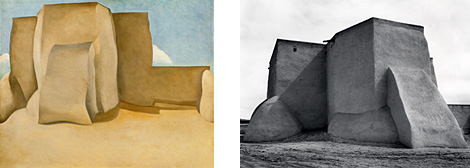
Left: Georgia O'Keeffe, Ranchos Church No.1, 1929, Oil on canvas, 18 3/4 x 24 inches, CR 664, Norton Museum of Art, West Palm Beach, Florida, © Georgia O’Keeffe Museum. Right: Ansel Adams, Saint Francis Church Ranchos de Taos, New Mexico, c. 1929, Gelatin silver print, 13 5/16 x 17 9/16 inches, Collection Center for Creative Photography, University of Arizona, ©The Ansel Adams Publishing Rights Trust.
I think of Ansel Adams as the Walt Whitman of American photography, creating "silent songs" about monumental landscapes. Georgia O'Keeffe, on the other hand, reminds me of Emily Dickinson. Of course, Dickinson hardly ever left the perimeter of Amherst, but it's not a geographic similarity they share, it's more a sensibility that goes beyond their solitary work. A Dickinson poem, or an O'Keeffe painting often presents the greatest reward to those who can see the deepest.
Natural Affinities, the exhibition of O'Keeffe and Adams' work currently up at American Art (thru January 4, 2009) is an ecstatic look at the work and lives two of the masters of the twentieth century. Adams captured the landscape in luminous black and white, yet in a voice that soars. O'Keeffe painted the world around her—sky, flower, skull—with an earthy palette that draws the viewer in. When both artists visions' overlapped, say in their take on the Saint Francis Church at Ranchos de Taos, New Mexico, the result is staggering.
Both artists created these works in 1929, around the time of their first meeting. Theirs would be a lifelong friendship, with some breaks, and each would be propelled into greatness by Alfred Stieglitz, artistic visionary and O'Keeffe's husband. Taking a look at the Ranchos church, O'Keeffe's is solid, yet it floats: at times it even aspires to flesh. In Adams' view, the church becomes a monolith, solid and earth-bound. Looking at one and then the other creates a dialogue, about painting, photography, and the very nature of seeing things.
The exhibition is filled with such wonders, but it's closing January 4. Take a look and let me know what you see. And as an added feature download our audio companion to the exhibition from our American Art podcast series on iTunes.
Posted by Howard on December 30, 2008 in American Art Here
Permalink
| Comments (1)
States of Grace: Remembering Grace Hartigan (1922–2008)
December 23, 2008
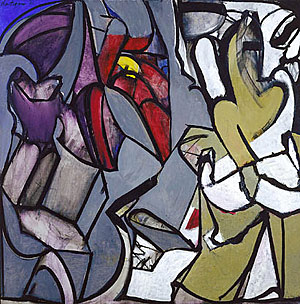
Frank O'Hara by Grace Hartigan
"I didn't choose painting," Grace Hartigan once told an interviewer, "It chose me. I didn't have any talent. I just had genius."
I came to Grace Hartigan through her association with the poet Frank O'Hara. As a grad student in creative writing living in New York I became interested in O'Hara and his work. I learned about his deep friendship with the abstract expressionist painter Grace Hartigan, who died a few weeks ago in Maryland. Both synthesized high art and popular culture in their works and both could find inspiration in the everyday. Both Hartigan and O'Hara were integral to New York's vivid art scene that flourished (mostly) downtown following World War II.
In fact, the words on O'Hara's gravestone pay homage to his great friend; "Grace/to be born and live as variously as possible." In those two lines O'Hara intertwined his own self and that of Hartigan. To live variously would be to experience as widely as possible what wells up in existence. To express it in one's art is what O'Hara and Hartigan did. There is the miracle of the everyday minor experience that is articulated and crystalized in O'Hara (one of his poems is called Having a Coke With You). He and Hartigan were unafraid to admit the variety in life. I believe that's him in the right side of the painting, about to walk through the dizzying cityscape that was, and still is, Manhattan.
Hartigan, a protean figure on the art scene, was viewed as a forerunner of Pop Art in her integration of everyday images in the midst of her abstract expressionism. At first, she started showing her work under the name "George Hartigan." She would say it was out of her respect for writer Georges Sand. She thought that being presented as a man who make people take her work more seriously. Thanks to Hartigan and others, that is no longer a problem.
Posted by Howard on December 23, 2008 in American Art Elsewhere, American Art Here
Permalink
| Comments (2)
The Marchbanks Calendar: December by Harry Cimino
December 18, 2008
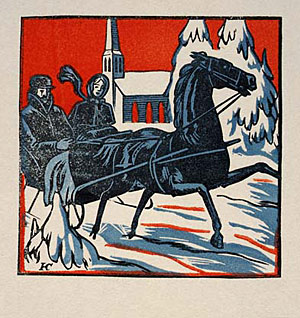
The Marchbanks Calendar—December by Harry Cimino
We've just turned the last page on this year's calendar and it's time to count down the days remaining in 2008. To take a good look at the last month of the year, I've chosen December from Harry Cimino's Marchbanks Calendar. The artist was born in Indiana in 1898 and died in New York in 1969. Not the longest life on record but certainly one that saw its share of changes, beginning while Queen Victoria was still in power, and ending when men were putting their footprints on the moon. Somewhere in between (as this woodcut is undated), Cimino crafted this image. From what I can gather, the work was likely done in the 1920s.
For me, it has that Currier and Ives feel of Americana deepened by the artist's choice of color. The red is vital to the sky and the church windows, while the gray-blue of the horse and riders carries most of the action (though the horse's hind legs seem to be lacking a certain rhythm). I like the woosh of the woman's scarf and the almost opposite effect of the man's blanket, which seems to be melting into the snow.
Cimino produced a calendar for the Marchbanks Company, and many of the illustrations are in American Art's collection. I hope we can look at more because they create miniature worlds that capture a time and place. Cimino also created woodcuts for book illustrations that also endear . . . and endure.
Posted by Howard on December 18, 2008 in American Art Here
Permalink
| Comments (1)
A Momentous Seventy-Fifth Art Anniversary
December 12, 2008
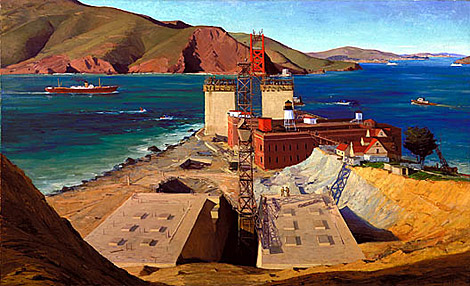
Ray Strong's Golden Gate Bridge
George Gurney, American Art's Deputy Chief Curator, came by my desk this afternoon to tell me today marked a special occasion in the art world.
On December 12, 1933, seventy-five years ago today, the Public Works of Art Project (PWAP) was founded. This was the first of four New Deal art projects. Artists were paid a minimum wage for completed art works that then became property of the government. The project was intended as a way to provide relief to artists and to bring art into public buildings. The PWAP lasted only seven months. Yet within that short period it employed 3,749 artists who were paid a total of $1,184,748.32 for 15,663 works of art. In April 1934, 511 items were exhibited at the Corcoran Gallery of Art in Washington. President Roosevelt and his wife Eleanor chose a number of these works to show in the White House. The success of the PWAP provided the impetus for the rest of the New Deal art programs.
On February 27, 2009, the Smithsonian American Art Museum will open 1934: A New Deal for Artists, which will feature PWAP paintings from our collection, including many shown in the White House and other federal buildings.
Posted by Jeff on December 12, 2008 in American Art Elsewhere, American Art Here
Permalink
| Comments (3)
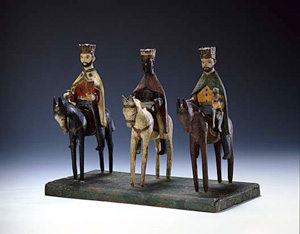

Recent Comments